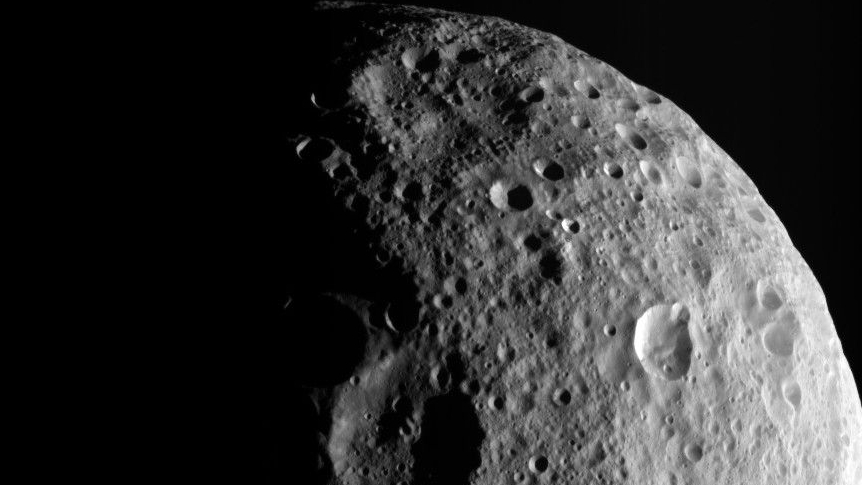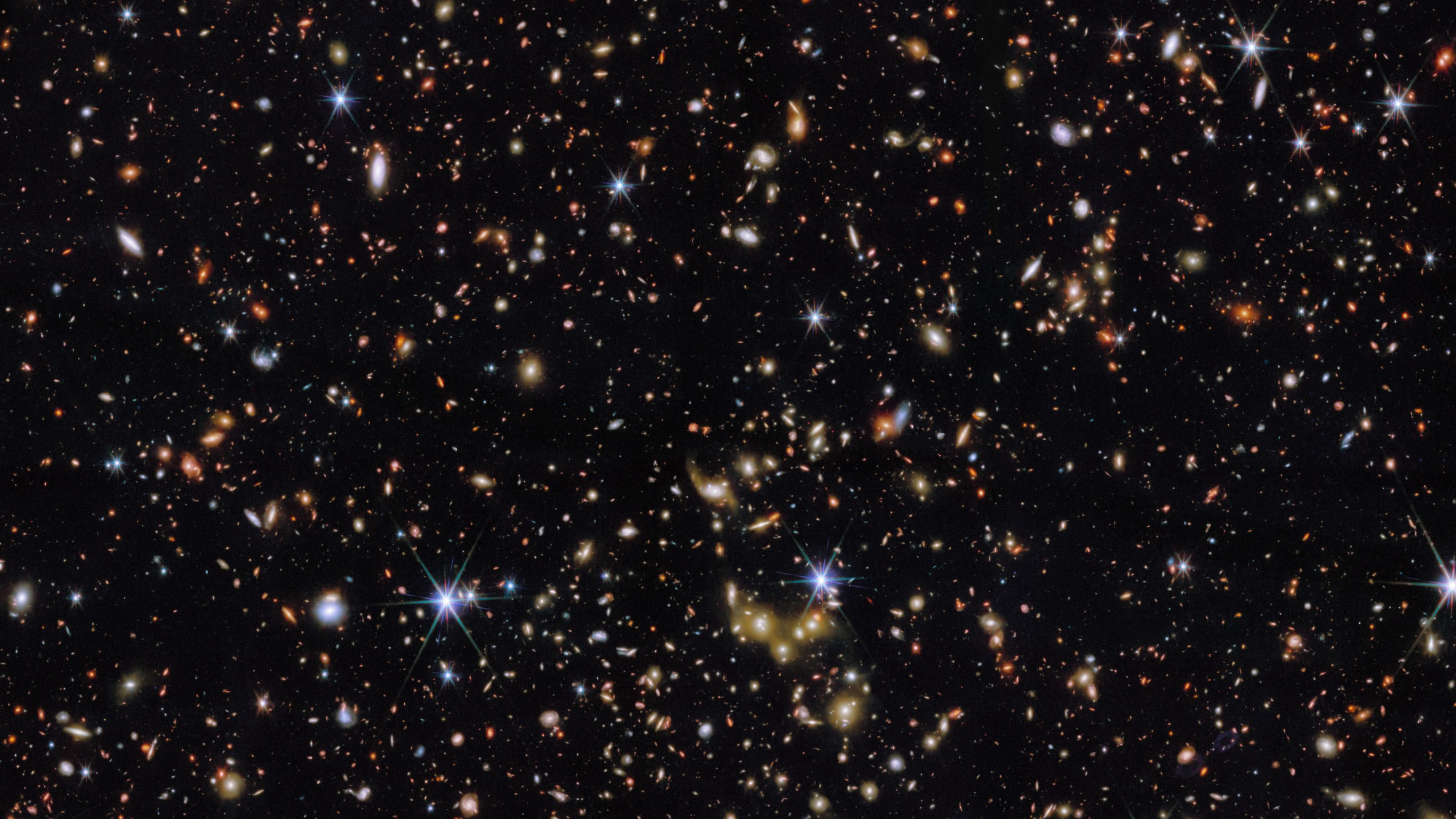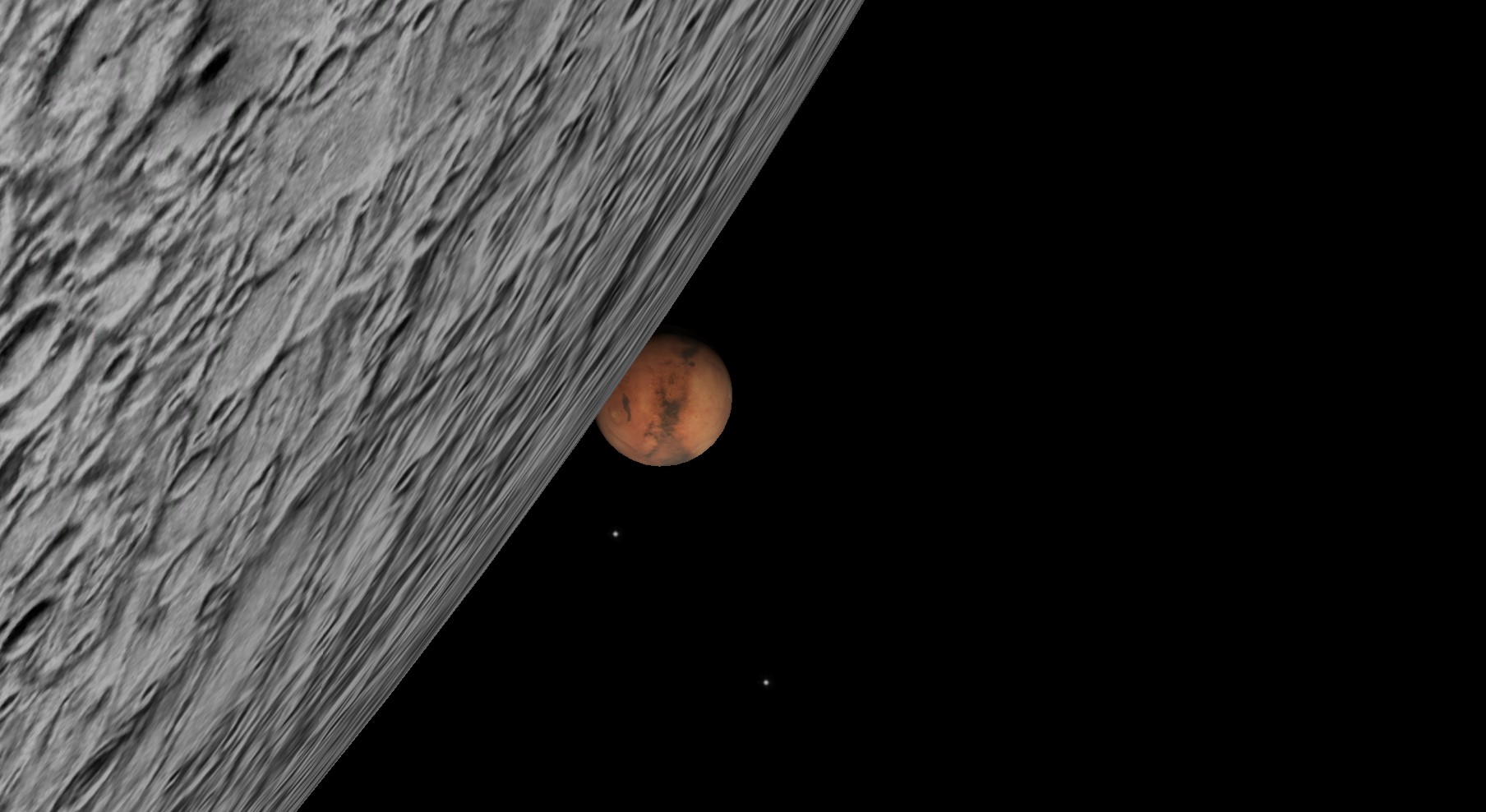
Every once in a while, something will appear in the sky that will attract the attention of even those who normally don't bother looking up. It's likely to be that way in the late-night hours of Saturday night/early Sunday morning (Sept. 5-6) when the waning gibbous moon, 86% illuminated, will appear in very close proximity to the now-brilliant planet Mars.
People who are unaware or have no advance notice will almost certainly wonder, as they cast a casual glance toward the moon on this holiday weekend night, just what is that "bright orange-yellow light" hovering just above the moon? Sometimes, such occasions bring with them a sudden rash of phone calls to local planetariums, weather offices, TV and radio stations and even police precincts.
Not a few of these calls excitedly inquire about "the mysterious UFO" that's closely hovering in the vicinity of our natural satellite!
Related: Watch Mars 'sneak' behind the crescent moon in these amazing views (video)
As a bonus, from the middle of South America and a narrow slice of western Africa, the moon will appear — for a short time — to hide or eclipse Mars from view during the predawn hours on Sunday morning. The actual term is called an occultation (Latin for "hiding"). An opportunity to see the moon occult a bright planet at night does not happen too often, so for those who are fortunate to live in the occultation zone, this upcoming event is one that really should not be missed.
Timings for many locations, as well as a map of the visibility zone of this "Mars eclipse," courtesy of David Dunham of the International Occultation Timers Association (IOTA) can be found at lunar-occultations.com.
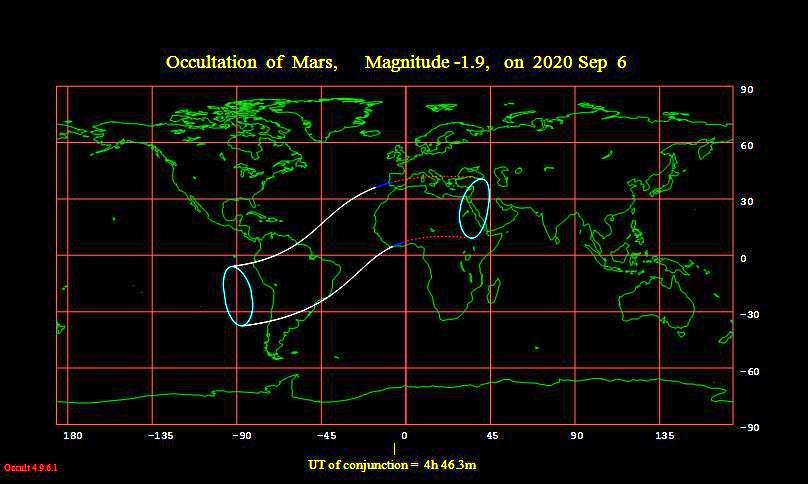
Getting closer and brighter
On Saturday night the Red Planet will be 44,243,000 miles (71,202,000 km) from Earth and approaching our planet at the rate of 183,000 miles (294,400 km) each day.
Get the Space.com Newsletter
Breaking space news, the latest updates on rocket launches, skywatching events and more!
Right now, Mars is becoming spectacular, as it is currently on target to make its closest approach to Earth until the year 2035 in just over a month. Think Mars (magnitude –1.9) is dazzling? On Oct. 6, when Mars makes its closest approach at a distance of just 38.57 million miles (62.06 million km), it will then glow nearly twice as bright as it does now!
Don't miss this near miss!
For those of us in North America, Saturday night will mean a very close conjunction of the moon to Mars (also sometimes called an "appulse"). The moon, moving around the Earth in an easterly direction at roughly its own apparent diameter each hour will seem to creep slowly toward and ultimately pass just below the ochre-colored planet. Even though North America will miss out on the occultation, Mars will almost command people to gawk at it, as it slowly appears to glide above the moon during the night.
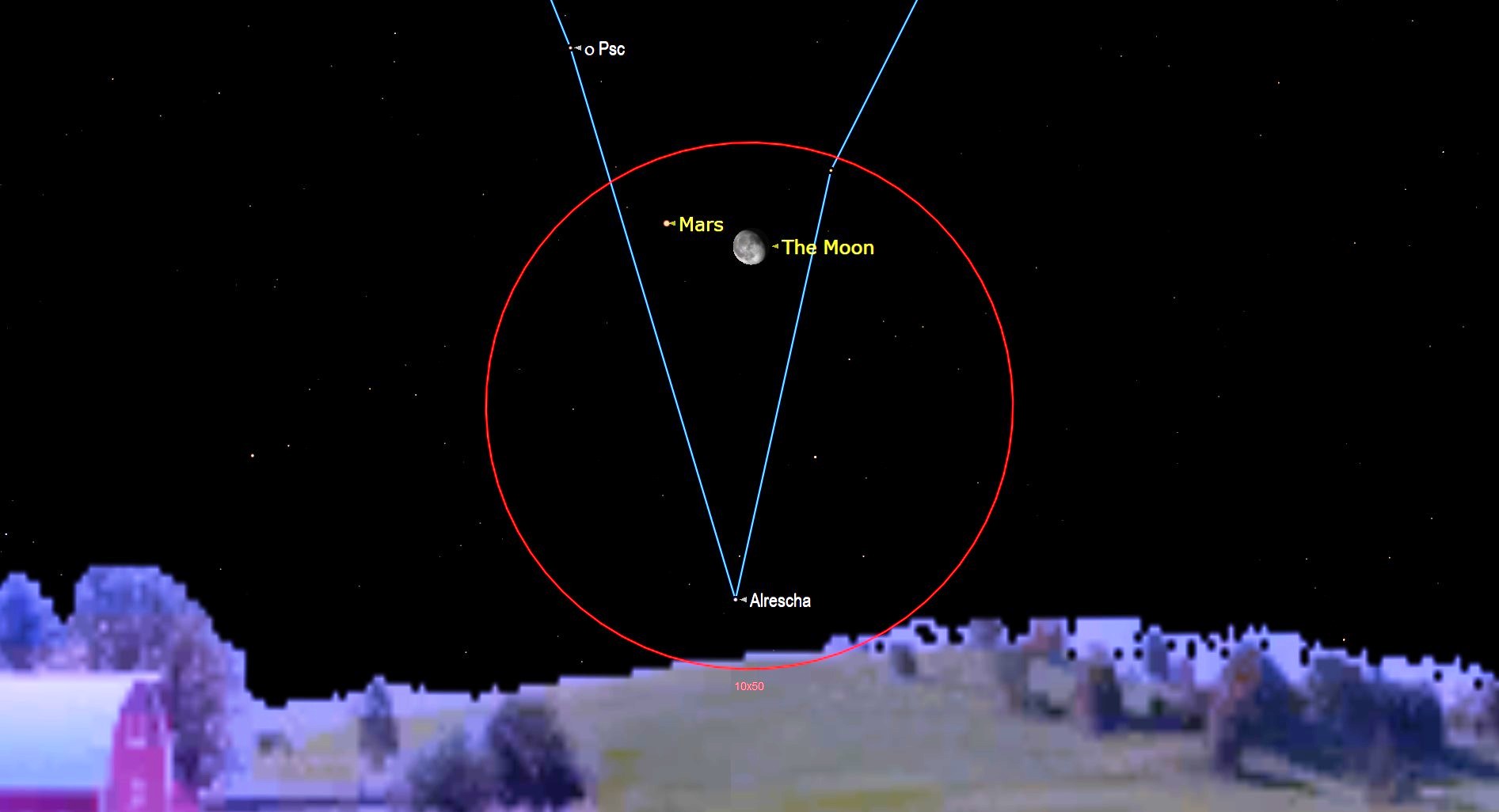
After closest approach, the moon will move slowly away from Mars; the gap between them will have widened appreciably by daybreak on Sunday morning.
For an example, as viewed from New York City, the moon and Mars will rise side-by-side at 9:15 p.m. local time. By 10 p.m. they will stand 10 degrees above the eastern horizon (your clenched fist held out at arm's length is roughly equal to 10 degrees). So, at that hour, the moon and Mars will be roughly "one fist" above the horizon. Mars will lie one degree from the moon's upper limb.
At 12:24 a.m. they will appear closest together, with Mars standing directly above the moon. They'll be separated by less than one-half degree. Thereafter, the moon will move on its way to the east and the gap between it and Mars will slowly increase. Three hours later, at around 3:30 a.m., you'll see the configuration has noticeably changed: Now the moon appears directly to the left of Mars; they'll be separated by one degree. And a half hour before sunrise — when all but the brightest stars and planets have faded away, Mars and the moon will still be readily visible in the dawn twilight, halfway up in the southwest sky. The moon will now be positioned well to the upper left of Mars.
Amazing illusions
In the table below, we provide a list of 16 selected cities, giving the times when the moon and Mars will appear closest together. In most cases, Mars will approach to within about 0.5 degrees of the upper limb of the moon. The moon itself is 0.5 degrees across, so you would think that the gap between Mars and the moon's upper limb would appear large enough to accommodate a moon-sized object. But when you gaze into the sky, the distance between Mars and the moon will actually appear only about half as large. That's because to our eyes, the moon appears about twice as big as compared to its actual angular diameter; an unusual illusion of size.
And the moon, of course, is nowhere near Mars in space. In fact, on this night the moon will be at apogee — its farthest point in its orbit from Earth, at 252,000 miles (405,600 km) away. But that's still more than 175 times closer than Mars.
But on this special Saturday night, they will be aligned in such a way to be positioned right next to each other, making for a head-turning sight!
| Location | Time Zone | Time of closest approach |
|---|---|---|
| Atlanta | EDT | 11:58 pm |
| Austin | CDT | 10:48 pm |
| Boston | EDT | 12:28 am |
| Chicago | CDT | 11:08 pm |
| Denver | MDT | 9:56 pm |
| Helena | MDT | 10:08 pm |
| Kansas City | CDT | 11:01 pm |
| Los Angeles | PDT | 9:22 pm* |
| Miami | EDT | 11:49 pm |
| Montreal | EDT | 12:33 pm |
| New Orleans | CDT | 10:48 pm |
| New York | EDT | 12:24 am |
| Seattle | PDT | 9:24 pm* |
| Tucson | MST | 8:58 pm* |
| Wash. D.C. | EDT | 12:13 am |
| Winnipeg | CDT | 11:18 pm |
| Row 16 - Cell 0 | Row 16 - Cell 1 | *As viewed from Los Angeles, Seattle and Tucson, closest approach comes shortly after moonrise |
| Row 17 - Cell 0 | Row 17 - Cell 1 | Row 17 - Cell 2 |
Joe Rao serves as an instructor and guest lecturer at New York's Hayden Planetarium. He writes about astronomy for Natural History magazine, the Farmers' Almanac and other publications. Follow us on Twitter @Spacedotcom and on Facebook.
Join our Space Forums to keep talking space on the latest missions, night sky and more! And if you have a news tip, correction or comment, let us know at: community@space.com.

Joe Rao is Space.com's skywatching columnist, as well as a veteran meteorologist and eclipse chaser who also serves as an instructor and guest lecturer at New York's Hayden Planetarium. He writes about astronomy for Natural History magazine, Sky & Telescope and other publications. Joe is an 8-time Emmy-nominated meteorologist who served the Putnam Valley region of New York for over 21 years. You can find him on Twitter and YouTube tracking lunar and solar eclipses, meteor showers and more. To find out Joe's latest project, visit him on Twitter.
-
rod I hope folks enjoyed some outdoor evening time last night. It was gorgeous here where I am at! I was out in my east pasture from 2000-2300 EDT. The big ticket items were viewing Jupiter and Saturn in Sagittarius. I used the 90-mm refractor and 10-inch, comparing views of these planets from 40x to 120x. The 10-inch showed 5 moons near Saturn, including Enceladus, excellent views of Cassini division, some cloud bands (I used #12 yellow filter), and some of the planet's shadow cast on the rings. The 90-mm refractor showed two Saturn moons. Jupiter's Great Red Spot became visible near 2040 EDT and crossed the central meridian of Jupiter near 2218 EDT as reported by Sky & Telescope. The 10-inch using #58 Green filter made viewing very easy, and tracking the Great Red Spot position changes on Jupiter as Jupiter rotated. About 2050 EDT, the Milky Way was very obvious running from Cygnus through Sagittarius with Jupiter and Saturn there. No dark sky view but still a pretty good show. Another great viewing treat was observing the waning gibbous Moon and Mars rise in Pisces. At 2213 EDT, on a road near a very large horse pasture, I enjoyed unobstructed unaided eye views of the pair, clear of a group of trees near my east pasture. Mars about 1-degree angular separation from the Moon. Observing the Moon and Mars through a number of hours during the night, you could see the position angle and separation of Moon and Mars take place. The Moon orbits Earth faster than the Earth rotates, a simple way of testing the Earth rotation and lunar orbital velocity. Both Mars and Moon will set after rising but the Moon is orbiting faster than Earth spins, moving faster so the angular separation and position angle of Mars changed relatively quickly while viewing periodically during the night. Out on the road, I could see the Moon, Mars, all along the ecliptic to Saturn and Jupiter position, and Sagittarius. Some excellent planet viewing last night----RodReply
